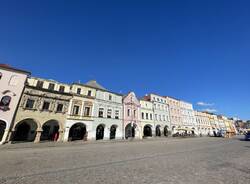Malpensa, an airport “leader” of the merchandise
The Minister Delrio is visiting “the moorland”. More than 60% of the Italian export products are produced within a radius of 250 km from the airport.

Milan Malpensa Airport is confirmed to be the first Italian airport for the cargo traffic and one of the biggest in the South Europe: in 2017, 575 thousand transported tons (7.5% more than 2016) and an incidence of 56% on the total amount of the aerial goods in Italy were registered. There were many official reports during the visit of the Minister for Transport and Infrastructure Graziano Delrio, who presented the Position Paper “Actions for the relaunch of the Aerial Cargo.”
One can still hear the old-fashioned definition of “an airport lost in the middle of nowhere”. This expression is repeated in the newspapers but it barely (or better, at all) considers the context, in which the airport is the hub of the most productive area of Italy. More than 60% of the Italian products allocated to export are indeed produced within a radius of 250 km from Malpensa, where 40% of the national businesses are located, which represent almost half of the GDP of the country. All the industrial sectors with a high inclination toward aerial exports, such as luxury, revolve around Malpensa. Today Milan Malpensa is the privileged transit door for businesses of the “made in Italy” that export goods and that aim to rapidly reach the most dynamic markets in the world.
The Lombard airport is the only one, among the top 10 European airports for goods traffic, located in South Europe and, so, it represents the most important landing point for cargo aircrafts in this strategic area of the continent. Not surprisingly, companies like FedEx and DHL turned Milan Malpensa into the main gateway of South Europe.
The Cargo City takes up a surface of about 500,000 m2 in the south-west area of the Milan Malpensa Airport, which is the only one in North Italy to have two adequate runways for the take-off and landing of the biggest cargo aircraft of the world, the Boeing 747-800, fully loaded. Moreover, it has a rest area for 20 cargo aircrafts.
There are 20 companies that operate at Milan Malpensa with cargo flights. There are about 210 cargo flights every week between take-offs and landings, with a total cargo capacity of about 7,500 tons a week. In addition to these, another 200 weekly intercontinental passenger flights, with “wide body” aircrafts of a good cargo capacity, have to be considered.
After the decentralization of Alitalia, the goods traffic of Milan Malpensa has continuously grown since 2012, with an annual average increase rate of 7.2%. When the new buildings, currently under construction, will be completed, the annual capacity of the airport will increase from 600,000 tons to over a million tons a year. The value of the goods exported by air from Milan Malpensa to non-EU countries in 2016 was 26 billion euros, with a share of 13% of the total amount of goods exported from Italy by all means of transport, whereas the value of the imports by air from non-EU countries was 17.3 billion (11.6% of the total in Italy).
Now, the next challenge for Milan Malpensa is to increase the amount of goods transported on passenger flights, in particular on the intercontinental routes. At the moment, 65% of the goods that transit in Malpensa uses cargo flights and the remaining 35% travels in the hold of passenger jets. Ideally speaking, according to experts, it should be 50-50. So, the increase by an annual average 3% in the period between 2016 and 2021 (according to the industrial plan of the SEA, the society for airport activities), forecast at Malpensa in the intercontinental section, going from 5.6 million intercontinental passengers in 2015 to 6 million in 2021, could be determining for a further growth.
The total surface of the Cargo City of Milan Malpensa includes about 90,000 m2 for warehouses (60,000 of which are in operation and 30,000 currently underway, which will be completed by 2018), 250,000 m2 for a rest area for cargo aircrafts and for loading and unloading operations, 150,000 m2 for driveability and parking areas for cars and trucks.
In the past 5 years, SEA has invested more than 70 million euros for buildings designated to goods traffic. Important investments on the airport also came from the main operators in the world of logistic, which use the airport areas and warehouses. Overall, they have contributed to the development of the infrastructure and the installations of Milan Malpensa with another 60 million investments, considering the forthcoming developments that will be completed in 2018.
During the visit, there was also the president of the Lombardy Region Roberto Maroni. The Region does not have power on the air transport strategies, but Maroni reiterated the effort on the land infrastructure to support the airport: “What we can do, and we are already doing,” he affirmed, “concerns infrastructure and mobility. We’re together with Anas and RFI to complete the railways connections, the T2 with Gallarate, which is going to allow Malpensa to become the reference point even for railways transport with all of North Europe.”
TAG ARTICOLO
La community di VareseNews
Loro ne fanno già parte
Ultimi commenti
Tsilvia su La patente a 18 anni? "Non è più uno status symbol"
PaoloFilterfree su "La sanità pubblica è a rischio privatizzazione": la raccolta firme on line contro il taglio delle tariffe
elenera su La patente a 18 anni? "Non è più uno status symbol"
Felice su La patente a 18 anni? "Non è più uno status symbol"
Alessandra Toni su "La sanità pubblica è a rischio privatizzazione": la raccolta firme on line contro il taglio delle tariffe
lenny54 su "La sanità pubblica è a rischio privatizzazione": la raccolta firme on line contro il taglio delle tariffe














Accedi o registrati per commentare questo articolo.
L'email è richiesta ma non verrà mostrata ai visitatori. Il contenuto di questo commento esprime il pensiero dell'autore e non rappresenta la linea editoriale di VareseNews.it, che rimane autonoma e indipendente. I messaggi inclusi nei commenti non sono testi giornalistici, ma post inviati dai singoli lettori che possono essere automaticamente pubblicati senza filtro preventivo. I commenti che includano uno o più link a siti esterni verranno rimossi in automatico dal sistema.